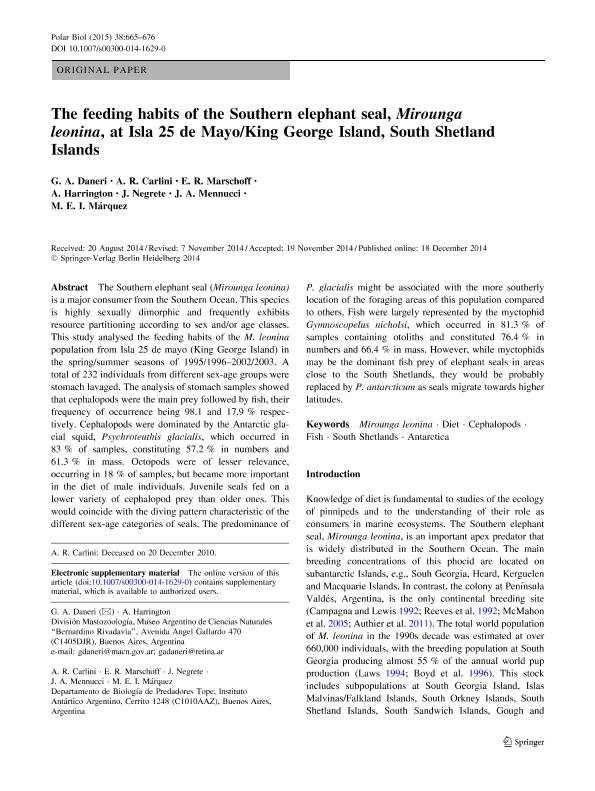Mostrar el registro sencillo del ítem
dc.contributor.author
Daneri, Gustavo Adolfo

dc.contributor.author
Carlini, A.R.
dc.contributor.author
Marschoff, Enrique Ricardo

dc.contributor.author
Harrington, Ana
dc.contributor.author
Negrete, Javier

dc.contributor.author
Mennucci, J.A.
dc.contributor.author
Márquez, M. E. I.
dc.date.available
2018-10-11T20:50:14Z
dc.date.issued
2015-05
dc.identifier.citation
Daneri, Gustavo Adolfo; Carlini, A.R.; Marschoff, Enrique Ricardo; Harrington, Ana; Negrete, Javier; et al.; The feeding habits of the Southern elephant seal, Mirounga leonina, at Isla 25 de Mayo/King George Island, South Shetland Islands; Springer; Polar Biology; 38; 5; 5-2015; 665-676
dc.identifier.issn
0722-4060
dc.identifier.uri
http://hdl.handle.net/11336/62264
dc.description.abstract
The Southern elephant seal (Mirounga leonina) is a major consumer from the Southern Ocean. This species is highly sexually dimorphic and frequently exhibits resource partitioning according to sex and/or age classes. This study analysed the feeding habits of the M. leonina population from Isla 25 de mayo (King George Island) in the spring/summer seasons of 1995/1996–2002/2003. A total of 232 individuals from different sex-age groups were stomach lavaged. The analysis of stomach samples showed that cephalopods were the main prey followed by fish, their frequency of occurrence being 98.1 and 17.9 % respectively. Cephalopods were dominated by the Antarctic glacial squid, Psychroteuthis glacialis, which occurred in 83 % of samples, constituting 57.2 % in numbers and 61.3 % in mass. Octopods were of lesser relevance, occurring in 18 % of samples, but became more important in the diet of male individuals. Juvenile seals fed on a lower variety of cephalopod prey than older ones. This would coincide with the diving pattern characteristic of the different sex-age categories of seals. The predominance of P. glacialis might be associated with the more southerly location of the foraging areas of this population compared to others. Fish were largely represented by the myctophid Gymnoscopelus nicholsi, which occurred in 81.3 % of samples containing otoliths and constituted 76.4 % in numbers and 66.4 % in mass. However, while myctophids may be the dominant fish prey of elephant seals in areas close to the South Shetlands, they would be probably replaced by P. antarcticum as seals migrate towards higher latitudes.
dc.format
application/pdf
dc.language.iso
eng
dc.publisher
Springer

dc.rights
info:eu-repo/semantics/openAccess
dc.rights.uri
https://creativecommons.org/licenses/by-nc-sa/2.5/ar/
dc.subject
Antarctica
dc.subject
Cephalopods
dc.subject
Diet
dc.subject
Fish
dc.subject
Mirounga Leonina
dc.subject
South Shetlands
dc.subject.classification
Otras Ciencias Biológicas

dc.subject.classification
Ciencias Biológicas

dc.subject.classification
CIENCIAS NATURALES Y EXACTAS

dc.title
The feeding habits of the Southern elephant seal, Mirounga leonina, at Isla 25 de Mayo/King George Island, South Shetland Islands
dc.type
info:eu-repo/semantics/article
dc.type
info:ar-repo/semantics/artículo
dc.type
info:eu-repo/semantics/publishedVersion
dc.date.updated
2018-10-09T21:21:51Z
dc.journal.volume
38
dc.journal.number
5
dc.journal.pagination
665-676
dc.journal.pais
Alemania

dc.journal.ciudad
Berlin
dc.description.fil
Fil: Daneri, Gustavo Adolfo. Consejo Nacional de Investigaciones Científicas y Técnicas; Argentina. Consejo Nacional de Investigaciones Científicas y Técnicas. Oficina de Coordinación Administrativa Parque Centenario. Museo Argentino de Ciencias Naturales “Bernardino Rivadavia”; Argentina
dc.description.fil
Fil: Carlini, A.R.. Ministerio de Relaciones Exteriores, Comercio Interno y Culto. Dirección Nacional del Antártico. Instituto Antártico Argentino; Argentina
dc.description.fil
Fil: Marschoff, Enrique Ricardo. Consejo Nacional de Investigaciones Científicas y Técnicas; Argentina. Ministerio de Relaciones Exteriores, Comercio Interno y Culto. Dirección Nacional del Antártico. Instituto Antártico Argentino; Argentina
dc.description.fil
Fil: Harrington, Ana. Consejo Nacional de Investigaciones Científicas y Técnicas. Oficina de Coordinación Administrativa Parque Centenario. Museo Argentino de Ciencias Naturales “Bernardino Rivadavia”; Argentina
dc.description.fil
Fil: Negrete, Javier. Consejo Nacional de Investigaciones Científicas y Técnicas; Argentina. Ministerio de Relaciones Exteriores, Comercio Interno y Culto. Dirección Nacional del Antártico. Instituto Antártico Argentino; Argentina
dc.description.fil
Fil: Mennucci, J.A.. Ministerio de Relaciones Exteriores, Comercio Interno y Culto. Dirección Nacional del Antártico. Instituto Antártico Argentino; Argentina
dc.description.fil
Fil: Márquez, M. E. I.. Ministerio de Relaciones Exteriores, Comercio Interno y Culto. Dirección Nacional del Antártico. Instituto Antártico Argentino; Argentina
dc.journal.title
Polar Biology

dc.relation.alternativeid
info:eu-repo/semantics/altIdentifier/url/https://link.springer.com/article/10.1007/s00300-014-1629-0
dc.relation.alternativeid
info:eu-repo/semantics/altIdentifier/doi/https://dx.doi.org/10.1007/s00300-014-1629-0
Archivos asociados
